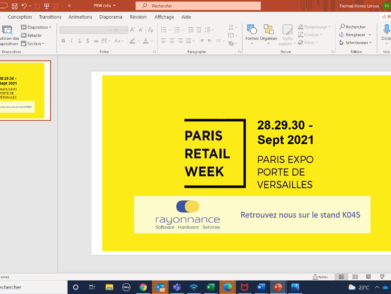
Covid 19: The big shift in technology uses in retail
Lockdowns, health measures and rapid changes in consumer behavior require retailers to adapt their tools, terminals and solutions just as nimbly. To offer more efficiency and security to their customers and their teams, while digitalization is experiencing an unprecedented growth in retail.
Tribune
The first lockdown on March 17, 2020 is a date to be remembered, heralding the beginning of profound changes in the lifestyle of the French people. Lasting transformations are affecting all areas of the economy, and retail is no exception, with increased digitalization that can no longer be ignored. According to the Banque de France, the use of contactless payments has increased “spectacularly”. The same is true for online and drive-through sales, whose growth curves have skyrocketed.
Behind these facts, an entire organization needs to be restructured. With the implementation of the traffic gauges, and a greater reluctance of the consumers, the role of the store will adapt, since it must present all the guarantees of sanitary safety, and offer an enhanced customer experience. This is a subject that also involves salespeople, ambassadors for their brands, who must now perform multiple tasks. First of all, they have to accompany or advise customers, but also inform them about the availability of products, collect cash on the move, prepare a Click & Collect or Ship from Store order or manage a product return from their mobile terminal. These are all elements that are reshuffling the cards in the retail industry, leading to changes in methods and sometimes in tools.
“Retailers can now take advantage of innovative technological solutions to not only improve their productivity, but above all to safely meet the needs of their customers and employees. By implementing new business models and safe and efficient workflows, they will be better prepared for the new era of commerce,” summarizes Elie Mura, Retail Director France at Zebra Technologies.
Digitalizing the salesperson and the point of sale
This era has already begun with the democratization of click&collect, home delivery, and the search for seamless paths. Ordering online, paying on receipt, or even with the deliveryman equipped with an adapted terminal will become a common gesture. This context reveals the adaptability of retailers, and a marker of their digital transition. Because these new schemes only work if the organization is ready to go, involving all the functions concerned. Whether at a distance or in-store, the act of buying, which has already been evolving under the pressure of changing behaviors for several years, is being revised in light of social distancing and health regulations. The limitation of queues and the management of flows are once again an imperative.
From constraint comes agility
In order to attract people back to the point of sale, the service and differentiation card is regaining its credentials. It is based, for example, on the planning of upstream visits (which requires tools and an adapted back office), a permanently available inventory to avoid customer frustration when a product is unavailable, or an optimized tracking of the supply chain. The range of actions is wide, our job today is to help our customers identify the keys solutions that make sense for them and for their customers, and to implement reliable and scalable solutions. Solutions that will help in-store salespeople on a daily basis and put them at the heart of omnichannel. The integration of all the data collected is also an opportunity to be seized, and to be put at the service of retailers to feed their datalake, refine sales forecasts, optimize stocks or the management of flows and delivery tracking. By accompanying more than 60 retailers in their digitalization of the store, we see the speed of the needs and the evolutions” notes Arnaud Affergan of the company RAYONNANCE, leader in mobility. The most agile retailers, who can combine these evolutions upstream, will score points with customers who are looking for such initiatives and reassuring processes. There are many examples of structural changes that can be applied right now. There is no need to wait for the famous “next world”, while the business has experienced in a few weeks changes that we thought would take several years.



